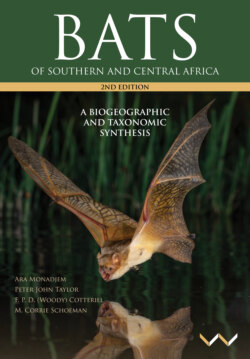Читать книгу Bats of Southern and Central Africa - Ara Monadjem - Страница 38
На сайте Литреса книга снята с продажи.
CLIMATES PAST AND PRESENT
ОглавлениеThe climate of southern Africa is dominated by a characteristic seasonality, with a cool-dry season interfacing with a hot-dry season, and then a hot-wet season, through the annual cycle. The southwestern Cape region experiences a winter-rainfall regime with hot, windy summers. A gradient of increasing rainfall trends from west to east; precipitation is both erratic and lowest in the deserts of the Namib, Namaqua, and the southwestern Kalahari. Adiabatic rainfall is not infrequent along the windward margins of the coastal escarpments and mountains. Prevailing mean annual temperatures and mean annual rainfall also exhibit an overall increase from south to north, with precipitation under increasing influence of the Inter-Tropical Convergence Zone and the Congo Air Boundary. The Monsoon rainfall system also influences the climate of northeastern Mozambique (Tyson and Preston-Whyte 2000).
The evolution of southern Africa’s landscapes and, especially, its vegetation has been influenced strongly by palaeoclimatic dynamics. Empirical evidence for past conditions across the hinterland is very poor, especially for the time before the Late Pleistocene (120,000 years ago). Nevertheless, the widespread fossil dune systems across the central and northern Kalahari Plateau testify to widespread arid conditions that prevailed across a vast portion of the subregion, presumably during the Late Cenozoic (de Menocal 2004, Goudie 2005). Such extreme periods of aridity were interspersed with equally humid phases, when mesic vegetation expanded south and west of the Congo basin (Benson and Irwin 1965).
Several lines of evidence suggest these expansions were focused along drainage lines in the Upper Congo and Zambezi systems. The significance of this interplay of both geomorphological evolution and palaeoclimatic dynamics in exercising dominant controls over palaeo-environments, is illustrated by the modern habitat mosaic characterising the Great Equatorial Divide. Here, Late Cenozoic drainage evolution has seen the overall migration of the Congo’s headwaters southward, by their repeated captures of Zambezi tributaries. These piracy events have culminated in the Great Equatorial Divide shifting south by ∼400 km through the Late Cenozoic (F. P. D. Cotterill, unpublished data). This has contributed significantly to a ‘shuffling’ juxtaposition of forest species and savanna species across these landscapes. It explains interesting biogeographical patterns in fishes (Schwarzer et al. 2012), mammals, birds (Cotterill 2002a, b, 2006) and snakes (Broadley et al. 2003), which are congruent with the high endemism and species richness of plants documented across this region (Linder 2001). This history is invoked to explain vicariant speciation of forest-adapted vertebrate species with their ranges centred on mushitu (gallery forest) and fringes of mesic miombo savannas in Katanga and northern Zambia. Alongside vegetation shifts that accompanied major changes in the palaeoclimate through the Plio-Pleistocene, this geomorphological evolution plausibly explains why the Ikelenge Pedicle (northwestern Zambia) and Katanga in the DRC are zones of high endemism. At least one horseshoe bat species, Rhinolophus sakejiensis, is known only from the Ikelenge Pedicle (Cotterill 2002a, b, 2006, Broadley et al. 2003). It is this forest–savanna mosaic that dominates the vegetation of the southern Congo basin and northern Angola, and justifies inclusion of such a vast portion of south-central Africa into this book (see Geographical Scope).
Figure 25. Biomes of southern and Central Africa, based on climate and plant architecture (modified after White 1983). The bold line at 4°S depicts the northern limit to the biogeographical region that underpins this synthesis of chiropteran diversity.
Figure 26. Ecoregions of southern and Central Africa (after Olson et al. 2001) are derived from the phytochoriological classification of White (1983). The bold line depicts the northern limit to the study area, which at 4°S approximates the southern limit of the belt of Congo closed forest, and the northern extent of the Guinea-Congolia/Zambesia Transition Zone.
